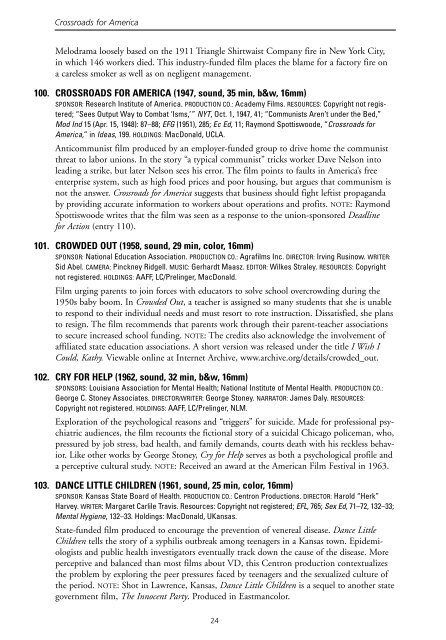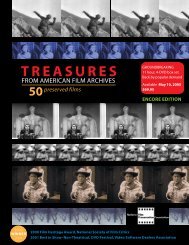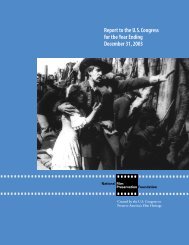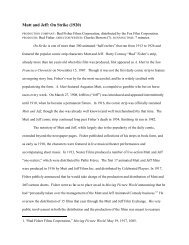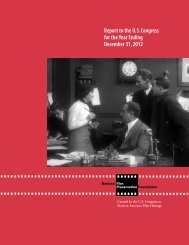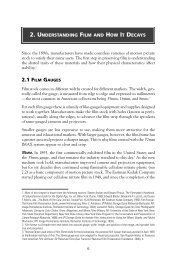Field Guide to Sponsored Films - National Film Preservation ...
Field Guide to Sponsored Films - National Film Preservation ...
Field Guide to Sponsored Films - National Film Preservation ...
You also want an ePaper? Increase the reach of your titles
YUMPU automatically turns print PDFs into web optimized ePapers that Google loves.
Crossroads for America<br />
Melodrama loosely based on the 1911 Triangle Shirtwaist Company fire in New York City,<br />
in which 146 workers died. This industry-funded film places the blame for a fac<strong>to</strong>ry fire on<br />
a careless smoker as well as on negligent management.<br />
100. CROSSROADS FOR AMERICA (1947, sound, 35 min, b&w, 16mm)<br />
SPONSOR: Research Institute of America. PRODUCTION CO.: Academy <strong><strong>Film</strong>s</strong>. RESOURCES: Copyright not registered;<br />
“Sees Output Way <strong>to</strong> Combat ‘Isms,’” NYT, Oct. 1, 1947, 41; “Communists Aren’t under the Bed,”<br />
Mod Ind 15 (Apr. 15, 1948): 87–88; EFG (1951), 285; Ec Ed, 11; Raymond Spottiswoode, “Crossroads for<br />
America,” in Ideas, 199. HOLDINGS: MacDonald, UCLA.<br />
Anticommunist film produced by an employer-funded group <strong>to</strong> drive home the communist<br />
threat <strong>to</strong> labor unions. In the s<strong>to</strong>ry “a typical communist” tricks worker Dave Nelson in<strong>to</strong><br />
leading a strike, but later Nelson sees his error. The film points <strong>to</strong> faults in America’s free<br />
enterprise system, such as high food prices and poor housing, but argues that communism is<br />
not the answer. Crossroads for America suggests that business should fight leftist propaganda<br />
by providing accurate information <strong>to</strong> workers about operations and profits. NOTE: Raymond<br />
Spottiswoode writes that the film was seen as a response <strong>to</strong> the union-sponsored Deadline<br />
for Action (entry 110).<br />
101. CROWDED OUT (1958, sound, 29 min, color, 16mm)<br />
SPONSOR: <strong>National</strong> Education Association. PRODUCTION CO.: Agrafilms Inc. DIRECTOR: Irving Rusinow. WRITER:<br />
Sid Abel. CAMERA: Pinckney Ridgell. MUSIC: Gerhardt Maasz. EDITOR: Wilkes Straley. RESOURCES: Copyright<br />
not registered. HOLDINGS: AAFF, LC/Prelinger, MacDonald.<br />
<strong>Film</strong> urging parents <strong>to</strong> join forces with educa<strong>to</strong>rs <strong>to</strong> solve school overcrowding during the<br />
1950s baby boom. In Crowded Out, a teacher is assigned so many students that she is unable<br />
<strong>to</strong> respond <strong>to</strong> their individual needs and must resort <strong>to</strong> rote instruction. Dissatisfied, she plans<br />
<strong>to</strong> resign. The film recommends that parents work through their parent-teacher associations<br />
<strong>to</strong> secure increased school funding. NOTE: The credits also acknowledge the involvement of<br />
affiliated state education associations. A short version was released under the title I Wish I<br />
Could, Kathy. Viewable online at Internet Archive, www.archive.org/details/crowded_out.<br />
102. CRY FOR HELP (1962, sound, 32 min, b&w, 16mm)<br />
SPONSORS: Louisiana Association for Mental Health; <strong>National</strong> Institute of Mental Health. PRODUCTION CO.:<br />
George C. S<strong>to</strong>ney Associates. DIRECTOR/WRITER: George S<strong>to</strong>ney. NARRATOR: James Daly. RESOURCES:<br />
Copyright not registered. HOLDINGS: AAFF, LC/Prelinger, NLM.<br />
Exploration of the psychological reasons and “triggers” for suicide. Made for professional psychiatric<br />
audiences, the film recounts the fictional s<strong>to</strong>ry of a suicidal Chicago policeman, who,<br />
pressured by job stress, bad health, and family demands, courts death with his reckless behavior.<br />
Like other works by George S<strong>to</strong>ney, Cry for Help serves as both a psychological profile and<br />
a perceptive cultural study. NOTE: Received an award at the American <strong>Film</strong> Festival in 1963.<br />
103. DANCE LITTLE CHILDREN (1961, sound, 25 min, color, 16mm)<br />
SPONSOR: Kansas State Board of Health. PRODUCTION CO.: Centron Productions. DIRECTOR: Harold “Herk”<br />
Harvey. WRITER: Margaret Carlile Travis. Resources: Copyright not registered; EFL, 765; Sex Ed, 71–72, 132–33;<br />
Mental Hygiene, 132–33. Holdings: MacDonald, UKansas.<br />
State-funded film produced <strong>to</strong> encourage the prevention of venereal disease. Dance Little<br />
Children tells the s<strong>to</strong>ry of a syphilis outbreak among teenagers in a Kansas <strong>to</strong>wn. Epidemiologists<br />
and public health investiga<strong>to</strong>rs eventually track down the cause of the disease. More<br />
perceptive and balanced than most films about VD, this Centron production contextualizes<br />
the problem by exploring the peer pressures faced by teenagers and the sexualized culture of<br />
the period. NOTE: Shot in Lawrence, Kansas, Dance Little Children is a sequel <strong>to</strong> another state<br />
government film, The Innocent Party. Produced in Eastmancolor.<br />
24


